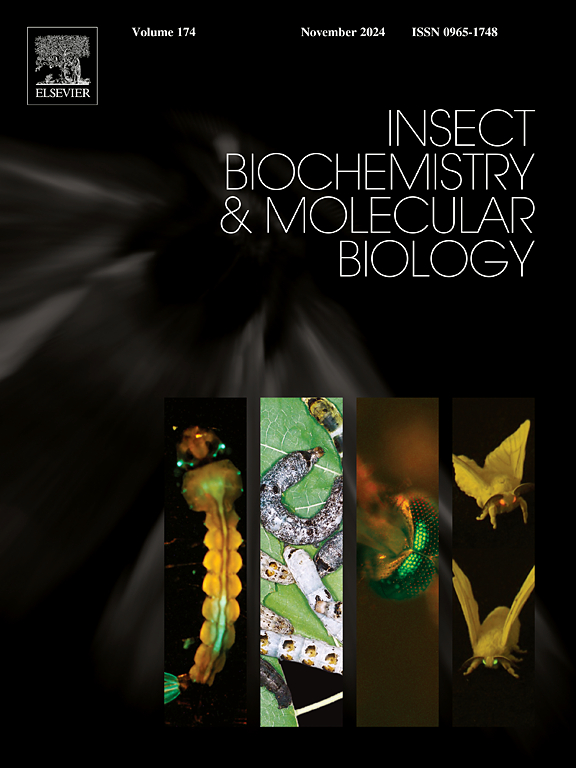代谢抗性和靶点抗性的协同作用增强了夜蛾对拟除虫菊酯类杀虫剂的抗性强度
IF 3.7
2区 农林科学
Q2 BIOCHEMISTRY & MOLECULAR BIOLOGY
引用次数: 0
摘要
杀虫剂的广泛使用给害虫种群带来了巨大的选择压力,推动了高水平抗性的进化,并导致害虫防治经常失败。杀虫剂抗性主要通过两种主要机制介导:靶点不敏感和代谢解毒增强。然而,这些机制之间潜在的相互作用和协同效应在很大程度上仍未被探索。在这项研究中,我们证明了这两种主要抗性机制之间的显著合作相互作用,在田间培育的一株夜蛾对拟除虫菊酯类杀虫剂蓝氯氰菊酯表现出极端抗性(631倍)。通过遗传定位和连锁分析,我们发现这种抗性表型是由电压门控钠通道中P450 CYP9A9(两个拷贝:CYP9A9a和CYP9A9b)和靶位点突变(L1014F, kdr)的过表达共同作用所赋予的。使用渐渗方法,我们产生了两个接近等基因的菌株:WH-kdr,只携带目标位点抗性等位基因(6.2倍抗性),和WH-CYP9A,只携带代谢抗性基因(79倍抗性),与敏感的WH-S菌株相比。CRISPR/ cas9介导的敲除QP19菌株的两个CYP9A9拷贝后,抗性从631倍显著降低到19倍,而转基因表达QP19菌株的CYP9A9a变体(含有3个氨基酸替换)在棉蚜中对高效氯氟氰菊酯产生了39倍的抗性。这些发现提供了令人信服的证据,表明靶位抗性可以显著增强代谢性抗性,导致抗性水平大大高于单靠任何一种机制。这些发现有助于了解抗性基因间相互作用介导的更高层次抗性机制,并为制定杀虫剂抗性管理策略提供理论依据。本文章由计算机程序翻译,如有差异,请以英文原文为准。

The synergism between metabolic and target-site resistance enhances the intensity of resistance to pyrethroids in Spodoptera exigua
The widespread application of insecticides imposes intense selective pressure on pest populations, driving the evolution of high-level resistance and leading to frequent control failures of pest. Insecticide resistance is primarily mediated through two primary mechanisms: target-site insensitivity and enhanced metabolic detoxification. However, the potential interactions and synergistic effects between these mechanisms remain largely unexplored. In this study, we demonstrate a striking cooperative interaction between these two major resistance mechanisms in a field-derived strain of Spodoptera exigua exhibiting extreme resistance (631-fold) to the pyrethroid insecticide lambda-cyhalothrin. Through genetic mapping and linkage analysis, we identified that this resistance phenotype is conferred by the combined effects of overexpression of the P450 CYP9A9 (two copies: CYP9A9a and CYP9A9b) and a target-site mutation (L1014F, kdr) in the voltage-gated sodium channel. Using an introgression approach, we generated two near-isogenic strains: WH-kdr, carrying only the target-site resistance allele (6.2-fold resistance), and WH-CYP9A, harboring only the metabolic resistance genes (79-fold resistance), both compared to the susceptible WH-S strain. CRISPR/Cas9-mediated knockout of both CYP9A9 copies in the QP19 strain dramatically reduced resistance from 631-fold to 19-fold, while transgenic expression of the CYP9A9a variant (containing three amino acid substitutions) from QP19 strain in Helicoverpa armigera conferred 39-fold resistance to lambda-cyhalothrin. These findings provide compelling evidence that target-site resistance can significantly potentiate metabolic resistance, resulting in substantially higher resistance levels than either mechanism alone in S. exigua. These findings enhance the understanding of higher level resistance mechanisms mediated by interactions between resistance genes and provide theoretical basis for devising management strategies of insecticide resistance.
求助全文
通过发布文献求助,成功后即可免费获取论文全文。
去求助
来源期刊
CiteScore
7.40
自引率
5.30%
发文量
105
审稿时长
40 days
期刊介绍:
This international journal publishes original contributions and mini-reviews in the fields of insect biochemistry and insect molecular biology. Main areas of interest are neurochemistry, hormone and pheromone biochemistry, enzymes and metabolism, hormone action and gene regulation, gene characterization and structure, pharmacology, immunology and cell and tissue culture. Papers on the biochemistry and molecular biology of other groups of arthropods are published if of general interest to the readership. Technique papers will be considered for publication if they significantly advance the field of insect biochemistry and molecular biology in the opinion of the Editors and Editorial Board.

 求助内容:
求助内容: 应助结果提醒方式:
应助结果提醒方式:


